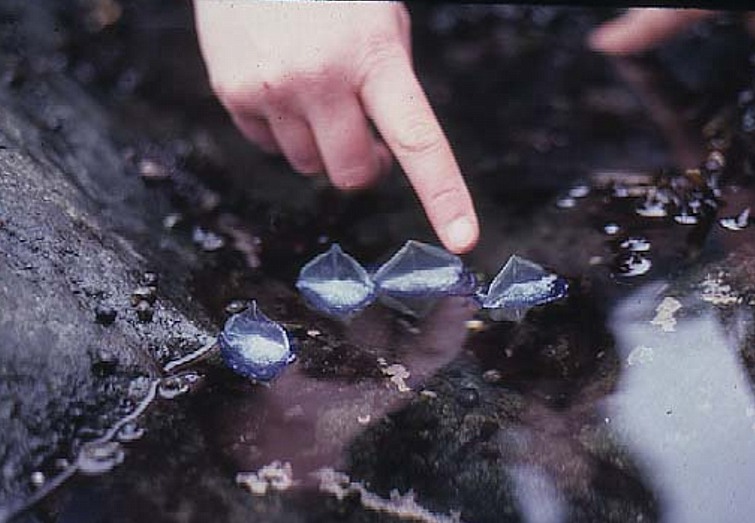Velella vellella are actually colonial hydroids, related to jellyfish and most closely related to the Portuguese Man-of-War. They occur only rarely in the waters of Race Rocks, coming in apparently with warmer Pacific currents. They were found washed up and stranded in a tide pool. The little fringe hanging on the bottom side are made up of the feeding tentacles.  “I have only seen Velella at Race Rocks twice since 1976. This picture I took in the early 1980’s shows a ‘flotilla’ in a tidepool.” (Garry Fletcher, 2005.)
“I have only seen Velella at Race Rocks twice since 1976. This picture I took in the early 1980’s shows a ‘flotilla’ in a tidepool.” (Garry Fletcher, 2005.)  In May of 2005, Wilfred Kroese of the Netherlands sent in this picture of a specimen he had found while touring in BC. When we informed him of the identity, he replied: “Due to your answer I was also able to find the Dutch name for it:‘bezaantje’, a name similar to one of the sails on a large sailboat. One that is attached to the rear mast.”
In May of 2005, Wilfred Kroese of the Netherlands sent in this picture of a specimen he had found while touring in BC. When we informed him of the identity, he replied: “Due to your answer I was also able to find the Dutch name for it:‘bezaantje’, a name similar to one of the sails on a large sailboat. One that is attached to the rear mast.”
Velella are actually colonial hydroids, related to jellyfish and most closely related to the Portuguese Man of War. They occur only rarely in the waters of Race Rocks, coming in apparently with warmer Pacific currents. They were found washed up and stranded in a tide pool. The little fringe hanging on the bottom side are made up of the feeding tentacles. They actually use their sails to traverse the open ocean in a group, and apparently in different hemispheres their ‘sails’ are angled differently to catch the wind and go with the proper currents…( Maybe that’s where early sailors figured out how to rig a ship!)
Physical appearsance: The Velella velella as been given the common name of by-the-wind-sailor because of its semicircular sail placed in a 45° angle on the float. The float contains a series of sealed air chambers that provide its buoyancy. This part of the by-the-wind-sailor is easily recognizable by its deep blue color; it can also measure up to 10cm in length. Hanging down from the float, you can also observe short tentacles. If the wind is blowing … – North-West, South-East: the float will drift left of the wind direction – South-West, North-East: the float will drift right of the wind direction Global distribution: This organism is found all around the world, in temperate or tropical seas.
Habitat: The Velella velella lives on the surface of the open ocean. After a storm you can also found them by the coasts.
Feeding: This organism feeds on pelagic organisms, including young fish and zooplankton. Predators: The by-the-wind-sailor has three predators: a sea slug, Fiona Pinnata; a sunfish, Mola Mola and a violet snail, Janthina Janthina.
Mode of reproduction: the sexual reproduction and early development are little none. Interesting fact: The Velella velella is not dangerous to humans but its better if you don’t touch them. If you do, don’t touch sensible skin such as your eyes or your face because some irritation may result.
Classification:
| Domain | Eukarya |
| Kingdom | Animalia |
| Phylum | Cnidaria |
| Class | Hydrozoa |
| Order | Hydroida |
| Family | Velellidaea |
| Genus | Velella |
| Species | velella |
| Common Name: | by-the-wind sailor |
References: N. Kozloff, Eugene. Marine Invertebrates of the Pacific Northwest. Seattle and London: university of Washington press, 1996 Morris, Abbott, Haderline. Intertidal Invertebrates of California. Stanford, California: Stanford University Press, 1980. Velella velella. By-the-wind-sailor. 2003. Marine Biological Association of the United Kingdom. November 10th 2005. http://www.marlin.ac.uk/species/Velellavelella.htm Velella Velella. 2003. National Sea Grant College Program of the U.S. Department of Commerce’s National Oceanic and Atmospheric Administration. November 10th 2005.http://seagrant.oregonstate.edu/sgpubs/onlinepubs/g03004.pdf “David Wrobel.” Velella Velella (Linnaeus, 1758): By-the-wind Sailor. The Jellies zone. November 10th 2005. http://jellieszone.com/velella.htm
see this link for other hydroids: https://www.racerocks.ca/tag/hydroid/
|
This file is provided as part of a collaborative effort by the students, faculty,staff and volunteers of Lester B. Pearson College
|
2005 | Virginie PC year 32 |